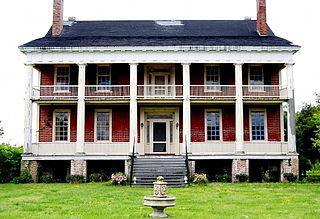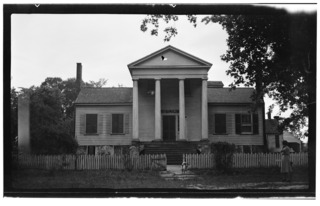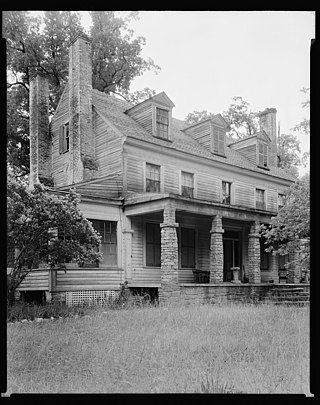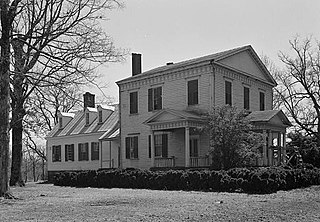
Henderson is a city and the county seat of Vance County, North Carolina, United States. The population was 15,060 at the 2020 census.

Somerset Place is a former plantation near Creswell in Washington County, North Carolina, along the northern shore of Lake Phelps, and now a State Historic Site that belongs to the North Carolina Department of Natural and Cultural Resources. Somerset Place operated as a plantation from 1785 until 1865. Before the end of the American Civil War, Somerset Place had become one of the Upper South's largest plantations.

The Carson House is a historic house and museum located in Marion, North Carolina. It was the home of Col. John Carson, and served as the McDowell County courthouse when the county was first organized in 1842.

Hillsborough Historic District is a national historic district located at Hillsborough, Orange County, North Carolina. The district encompasses 529 contributing buildings, 9 contributing sites, 13 contributing structures, and 2 contributing objects in the central business district and surrounding residential sections of Hillsborough. The district includes buildings dating to the late-18th and early-20th century and includes notable examples of Federal, Greek Revival, and Italianate style architecture. Located in the district are the separately listed Burwell School, Eagle Lodge, Hazel-Nash House, Heartsease, Montrose, Nash Law Office, Nash-Hooper House, Old Orange County Courthouse, Poplar Hill, Ruffin-Roulhac House, Sans Souci, and St. Matthew's Episcopal Church and Churchyard. Other notable buildings include Seven Hearths, the Presbyterian Church (1815-1816), Methodist Church (1859-1860), First Baptist Church (1862-1870), Twin Chimneys, and the Berry Brick House.

St. John's Episcopal Church is a historic Episcopal church located on SR 1329 in Williamsboro, Vance County, North Carolina. It was built in 1773, and is a rectangular, seven bay long, frame church on a brick foundation. It has a gable roof and is sheathed in weatherboard. The church was restored in the 1950s.

Botany Bay Heritage Preserve & Wildlife Management Area is a state preserve on Edisto Island, South Carolina. Botany Bay Plantation was formed in the 1930s from the merger of the Colonial-era Sea Cloud Plantation and Bleak Hall Plantation. In 1977, it was bequeathed to the state as a wildlife preserve; it was opened to the public in 2008. The preserve includes a number of registered historic sites, including two listed in the National Register of Historic Places: a set of three surviving 1840s outbuildings from Bleak Hall Plantation, and the prehistoric Fig Island shell rings.

Jones–Jarvis House, also known as General Foster's Headquarters and Jarvis–Slover House, is a historic home located at New Bern, Craven County, North Carolina. It was built about 1810, and is a 2+1⁄2-story, three-bay, side-hall plan, Federal style brick dwelling. It has a one-story brick and frame rear wing. During the American Civil War, General John G. Foster moved into this house, and it served first as his residence and later as part of the headquarters of the Eighteenth Army Corps.

Slover-Bradham House is a historic house located at New Bern, Craven County, North Carolina. It was built about 1848, and is a three-story, Renaissance style brick dwelling with a low hipped roof. During the American Civil War, under the direction of General Ambrose Burnside it served as headquarters of the Eighteenth Army Corps and the Department of North Carolina. Pepsi Cola inventor Caleb Bradham owned the house from 1908 until 1934.
Rose Hill, later known as Timberlake House, is a historic plantation house located near Louisburg, Franklin County, North Carolina. The main block was built about 1803, and is a two-story, five-bay, transitional Georgian / Federal style frame dwelling. It has a gable roof and double-shouldered brick end chimneys. A rear ell was expanded about 1840, and about 1880 a one-story Queen Anne-style, full width verandah was added. About 1910, a Neoclassical portico was added over the verandah, as was a bathroom wing. Also on the property are the contributing slave quarter, kitchen, playhouse, and generator / wellhouse.

Cove Grove is a historic plantation house located near Hertford, Perquimans County, North Carolina. It was built about 1830, and is a two-story, five-bay, transitional Federal / Greek Revival style frame dwelling. It has a gable roof and features front and rear full-height porticoes supported by Ionic order columns.

Land's End, also known as Leigh House, is a historic plantation house located near Hertford, Perquimans County, North Carolina. It was built about 1830, and is a two-story, five bay by four bay, Greek Revival style brick dwelling. It has a gable roof and features front and rear full-height porticoes supported by unfluted Doric order columns.

Sutton-Newby House is a historic plantation house located near Hertford, Perquimans County, North Carolina. It was built about 1745, and is a 1+1⁄2-story, four-bay, frame dwelling with a brick end and gable roof. It originally had both ends in brick. It features a full-width, shed roofed front porch and massive double-shouldered chimney. It is a member of the small group of 18th century frame houses with brick ends in northeast North Carolina; the group includes the Myers-White House and the Old Brick House.

Stockton is a historic plantation house located near Woodville, Perquimans County, North Carolina. It was built in 1840, by Josiah T. Granbery and consists of a two-story, three-bay, temple form central section flanked by one-story wings. The Greek Revival style frame house has gable roofs on each section and a prostyle tetrastyle Doric order portico on the front of the central section. It was the boyhood home of Robert W. Welch Jr. (1899-1930). The house and 500 acres was then sold to Alvie Cook in 1935 who owned it until his death in 1970. Alvie and Mabel Cook raised five daughters in the home: Marguerite, Sue, Peggy, Grace, and Mabel Louise. After Alvie's death, Mabel Cook, sold it in 1972 to Eugene and Ellen Rountree. In 1992 Historic Preservation Foundation of North Carolina holds Protective Covenants and the house is sold to Terry L. and LuAnn H. Cobbs who own Stockton to this day.

Seven Hearths is a historic plantation house located near Tryon, Polk County, North Carolina. It was built about 1800 for Marvel (Marville) Mills - assumed built by his father Major William Mills, and is a two-story, five-bay, Federal style frame dwelling. It has exterior gable end double shouldered chimneys and flanking one bay wide, one bay deep projections.

Ashland is a historic plantation house located near Henderson, Vance County, North Carolina. It consists of two sections dated to the late-18th and mid-19th centuries. The older section is a two-story, two-bay, frame section attached to the newer and taller two-story, three-bay frame section. Each section is sheathed in weatherboard and topped by gable roofs. The house displays elements of Federal and Greek Revival style architecture. Judge and colonizer Richard Henderson (1734–1785) owned the Ashland tract among his vast holdings.

Pool Rock Plantation is a historic plantation house located near Williamsboro, Vance County, North Carolina. It consists of two, two-story sections. The older was built in 1757 by James Mitchell, an immigrant from Lunenburg County, Virginia. His daughter, Amy Mitchell, married Michael Satterwhite in the house in 1759. It is a two-story, three-bay, Federal style frame structure. It forms the rear section. About 1855, a more ornate two-story, three-bay, Italianate style frame structure attributed to Jacob W. Holt (1811-1880). The later section has a shallow hipped roof and overhanging eaves. The two sections are joined by a two-story hallway linker. Also on the property is a contributing one-story, hip roof office building.

Pleasant Hill, also known as Rivenoak and Hawkins House, is a historic plantation house located near Middleburg, Vance County, North Carolina. It was built in 1759 and remodeled in the 1850s in the Greek Revival style. It is a 2+1⁄2-story, five-bay, Georgian double pile plan frame dwelling. It has a moderately steep gable roof with dormers and double-shoulder brick chimneys. The original dwelling was probably built by Philemon Hawkins, Jr., and birthplace of Governor William Hawkins (1777-1819).
Belvidere, also known as the Boyd House, is a historic plantation house located near Williamsboro, Vance County, North Carolina. It is attributed to architect Jacob W. Holt and built about 1850. It is a two-story, double-pile frame Greek Revival / Italianate style frame dwelling. It has a high hipped roof with bracketed eaves. The front facade features a full-width porch with hipped roof and brackets. Also on the property is a contributing one-story, heavy timber-frame school house.

Elgin is a historic plantation house located near Warrenton, Warren County, North Carolina. It was built about 1835, and is a two-story, three-bay, Federal style temple-form frame dwelling. It has a gable roof, pedimented front porch, and flanking porches. At the rear is an earlier 1+1⁄2-story frame dwelling with a gable roof. The front facade features a Palladian entrance with sidelights and Tuscan colonnettes. The house is similar in style to Dalkeith.

Williamsboro or Williamsborough is an unincorporated community in Vance County, North Carolina, United States. It was established in about 1755 as Williamsborough in Granville County in the Province of North Carolina. It became part of Vance County in 1881 when Vance County was founded. Williamsboro is located in Williamsboro Township, which is an administrative division of Vance County.





















